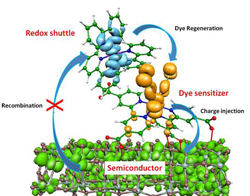Inexpensive electricity powered by the Sun
Solar cells are devices that convert the Sun's energy into electricity. Their obvious benefits compared to the combustion of fossil fuels include sustainable production (a virtually limitless supply of fuel) and next to no harmful emissions. Conventional photovoltaic (PV) devices use inorganic semiconductor technology. Despite the huge terrestrial solar resource and impressive annual growth of the industry, widespread uptake of inorganic semiconductor solar cell technology has been limited by cost effectiveness when seen in light of energy conversion efficiency. Organic and hybrid technology (a combination of organic and inorganic) could revolutionise the industry now that its previously limited efficiency is approaching competitive levels. Solar cells based on such technology are superior in capturing light over a full range of intensity including under cloudy or hazy conditions or at low angles of incoming light. Their ability to produce a stable maximum power output combined with low cost of materials is promising, especially for building integrated and indoor photovoltaic solutions. European scientists initiated the 'Efficient Solar Cells based on Organic and hybRid Technology' (Escort) project to develop innovative materials and processes for producing enhanced dye-sensitised solar cells (DSSCs). DSSCs use a photosensitive organic dye to absorb sunlight and create energy from excited electrons in a way that mimics photosynthesis. Electrons are injected onto an inexpensive inorganic semiconductor, such as titanium dioxide (TiO2), while holes are transferred to a redox shuttle. The consortium is combining DSSCs expertise in the EU and India and using creative molecular engineering and recent advances in nanotechnology. Scientists are investigating all critical DSSC subsystems to develop novel materials and processes to significantly increase DSSC conversion efficiency. Results to date cover development of novel dye sensitisers, nano-structured TiO2 and nano-structured anti-reflective coatings, as well as improved redox shuttles. DSSCs have been assembled with good reproducibility and are being tested. Advances have appeared in 30 scientific papers published in peer-reviewed journals (please check the project web site for updates). Escort technology will go beyond the state of the art enhancing widespread uptake of DSSCs. In addition to climate and environmental benefits India's nearly 640 000 villages would witness an important increase in living standards thanks to low-cost solar energy for homes, hospitals and schools.







